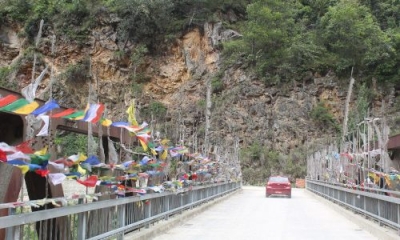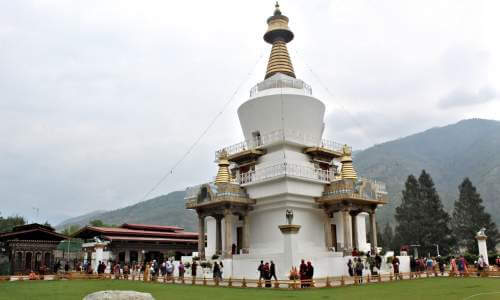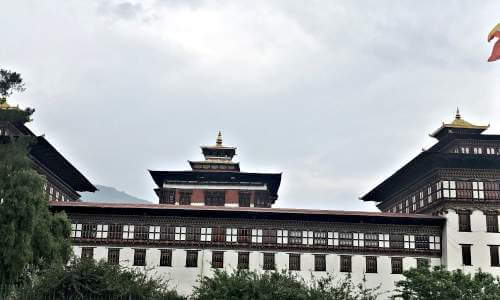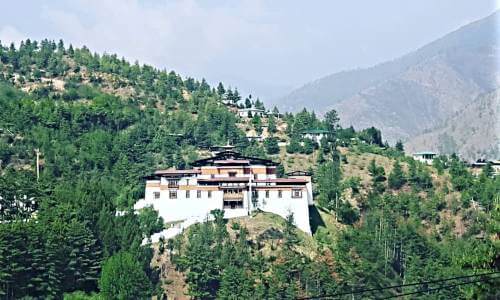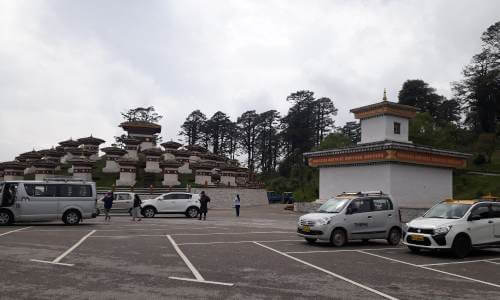The largest city of Bhutan, Thimphu sits as the country’s glorious capital, also serving as the political and monastic headquarters. The third highest capital in the world, is by far the most modern city in the kingdom and is dotted with tons of good restaurants, cafes and bars. Having said that, Thimphu still preserves its old world charm paving its way out for a small town feel soaked in fascinating culture and history.
Tourists are never short on finding interesting things to do during their holidays in Thimphu. The capital city houses some of the most important historical, cultural and political landmarks that make for popular tourist attractions visited by many. One of the most striking places to visit in the city that happens to be on every itinerary is by far the ancient hill fortress, ‘Trashi Chho Dzong’. Nestled along the Thimphu River, the fortress today, houses the government’s administrative offices and impresses everyone with its splendid architecture overlooking a cascade of terraced fields.
Sightseeing in Thimphu is not complete without visiting the magnificent site of ‘Buddha Dordenma’. Sitting atop a hill overlooking the beautiful city of Thimphu, it is considered the world’s largest seating gilded Buddha and attracts uncountable visitors seeking peace and spirituality. ‘National Memorial Chorten’ is yet another place must visit when in the capital city. Focus of daily worship for the Bhutanese, it is always abuzz with religious activity. Early morning is the best time to visit here and see the elderly people do kora and light butter lamps.
Thimphu has something in store for adventure junkies too; the Motithang Preserve, located 15 minutes drive from the town, is a place to witness the national animal, Takin, in action. And if trekking is something on your mind, the legendary ‘Dochula Pass’ towering at 3140 metres above sea level, will definitely leave you in awe of its hypnotic mountain scenery and blissful vibes.
Besides sightseeing, Thimphu is a hub for many fascinating activities that are often not on a conventional traveller’s radar; watching a game of archery and indulging in textile weaving, papermaking and goldsmith workshops make few of the most recommended offbeat things to do when in this beautiful Himalayan country.
No trip to Thimphu is complete without indulging in the retail therapy experience; the ‘Craft Market’ and ‘Centenary Farmer’s Weekend Market’ make for two of the must visit places in the city. Brimming with stalls selling everything ranging from thangkas, prayer wheels and Buddha figurines to homemade yak cheese, wild honey and fiery hot chilies, you are sure to leave from here with a great shopping extravaganza.
Visit Dochula
Visitors to Bhutan should never miss out visiting the Dochula Pass. It is a magnificent pass that cuts through the snow covered Himalayas on the road which connects Thimphu to Punakha. The pass is dotted with several memorable landmarks, one of the most famous of which is the Druk Wangyal Khang Zhang Chortens. The pass also enjoys an immense popularity with the tourists since it provides a 360 degree view of the Himalayas. On days when the weather is clear, the view is one that easily wins your heart.
The Dochula Pass also impresses everybody with its impressive size, as it enjoys an elevation of 3,100 meters approx. Enormous snow capped Himalayan peaks can be viewed on the eastern end. Among the most famous of these is Mt. Masanggang, which reaches the skies at a height of almost 7158 meters.
Because of its immense altitude, the weather at the Dochula Pass remains foggy throughout the year. Visit it between the months of February and October, and you will be treated to breathtaking views of the Bhutan Himalayas. Lovely forest covers embrace the passes, while the hill slopes surrounding it are marked by colourful religious flags which are holy to the Buddhists. Visit it during February, after the end of the Losar Festival, and the Dochula Pass presents a colourful spectacle of different flowers. During the month of March, rhododendrons are in full bloom.
While visiting Dochula Pass during the course of your Bhutan sightseeing tour, you should also visit the three famous landmarks dotting it. One of these is 108 Druk Wangyal Khang Zhang Chortens or stupas. In the local language, they are called chortens of victory, since they were built to honour those Bhutanese soldiers who lost their lives during the fight against insurgents. It also marks the victory of King Jigme Wangchuk who forced the insurgents to abandon their camps and flee the country.
The other famous landmark, Druk Wangyal Lhakhang, was built and completed in 2008 to celebrate 100 years of monarchy in Bhutan. The walls are a particular fascination, as they are adorned with paintings on Bhutanese history.
The third landmark is the Royal Botanical Park, which is home to 46 species of rhododendrons. While 18 of these belong originally to the park, 26 of them have been brought from several places in Bhutan.
Visit Semtokha Dzong
The Simtokha Dzong is one of the most beautiful tourist attractions in Bhutan, and gets that beauty both by its inspiring architecture and its impressive location. It stands grandly on a projecting ride, overlooking the entire Thimphu valley spread out below.
This elegant structure was built by Zhabdrung Ngawang Namgyel, who is renowned for having built some of the most fabulous looking dzongs (a type of fortress architecture found mainly in Bhutan which serves several purposes, from monks’ accommodations to administrative offices). After having won certain territories in Western Bhutan, he looked to defend himself against both internal and external enemies. To achieve that purpose, he began building several dzongs, of which this is one.
It is widely believed that a famous Tibetan Lama (teacher of Dharma in Tibetan Buddhism), Lama Zhang, had predicted that a dzong would be constructed by Zhabdrung Ngawang Namgyel at the intersection of three western regions. Sure enough, that prophecy came true and today, and today, this beautiful dzong acts as the boundary to three western regions, Sha (wangduephodrang), Wng (Thimphu) and Pa (Paro).
There is also a famous mythology surrounding this fortress. It is believed that this area was home to many demons. The place where the dzong was to come up, was inhabited by a demon who harmed passers by. However, Zhabdrung defeated the demon and banished her into a rock on the hills where the dzong stands today. It was decided that to imprison the demon eternally, the rock should be enclosed, and that was what was done.
Visiting this dzong today can be an informative and delightful experience. This impressive fortress houses the Lama’s chamber, enemy dzong (which is a chamber used to store weapons), storeroom and monastic school. If you look above about 500 meters, your eyes catch the sight of the ruins of Simtokha DzongTa Dzong (watch tower). The left side of the fortress is marked by Chu Dzong (water fortress), which functions as a prayer hall for students today. To the front of the Simtokha Dzong, on the right, is a crematorium.
Visit Tashichho Dzong
When you visit Tashichho Dzong during your sightseeing tour to Bhutan, you will find that it is as impressive as the other dzongs. This impressive structure has served as the seat of the government since 1952. Today, it consists of the throne room, offices of the king, secretariat and the ministries of home affairs and finance. There are other government departments too, but most of them are located in buildings located nearby. Overlooked by mountains, it is noticeable from quite a distance. This has as much to do with its size as its white and red colour.
The Tashichho Dzong has an interesting history behind it. It was constructed in 1216 AD by Lama Gyalwa Lhanangpa on the same site where Dechen Phodrang now stands. Another structure known as the Lower Dzong was built in the year 1641 by Zhabdrung Ngawang Namgyal. A major fire destroyed much of the original dzong in 1771, leading to all valuable objects being shifted to the Lower Dzong. The new dzong which was built was expanded many times in the coming years. An earthquake destroyed most of it in 1897, before it was rebuilt in 1902. The dzong, as we see it today, was built in 1952 in Thimphu in the traditional style of architecture, involving the use of neither nails nor of written plans.
Another fact about Tashichho Dzong is that it lies in close proximity to Thimphu, right next to the banks of River Wang Chhu. Well manicured lawns surround it on all sides along with beautiful gardens. It has served as the seat of the government of Bhutan since 1968 and houses the throne room, offices of the king, cabinet secretariat and ministries of home and finance affairs. Inside the dzong there are thirty temples, shrines and chapels.
Visit National Memorial Chorten
One of the sights which greet you during your visit to Bhutan is that of chortens (it is a Buddhist shrine which is a monument to Lord Buddha). National Memorial Chorten is one of them. Also known as Thimphu Chorten, it is a major landmark in the city and is easily recognised with its golden spires and bells. In fact, more than being just a major landmark, it is also known as “the most visible religious landmark in Bhutan”.
National Memorial Chorten is a tourist attraction in Bhutan which you cannot miss easily. It is located in close proximity in the central part of Thimphu city. Upon visiting this iconic monument, your eyes will meet scores of elderly Bhutanese people circumambulating the Chorten for the greater part of the day. The word chorten, in the local language, means “the seat of faith”, while such monuments are often referred to by the Buddhists as “Mind of Buddha”.
The National Memorial Chorten, or the Thimphu Chorten, is built in the traditional Tibetan style of architecture. There is a pyramidal pillar topped by a crescent moon and sun. What makes it different from others though, is the round part of the structure which extends outwards at one end, thereby giving it the appearance of a vase. The chorten is also adorned with enormous images of wrathful deities in the company of their female counterparts.
You will easily be impressed by your visit to the National Memorial Chorten, as elegance shows itself both in its exteriors and interiors. As you enter, you are greeted with representations of three protective bodhisattvas (In Buddhism, a person who can attain nirvana but avoids doing so through compassion for other people). When you are finally inside the chorten, your eyes meet slated which are engraved with the images of the three gurus in Buddhism, Ngawang Namgyal, Gautama Buddha and Guru Padmasambhava. Large prayer wheels accompany these engravings. Even though there are four entrances to the chorten, only one of them remains open for the visitors. A special attraction of the chorten is the top floor which has lovely paintings depicting deities of the Nyingma school. On top of this floor is another one with a gallery in it. From here, you can get lovely views of the city.

